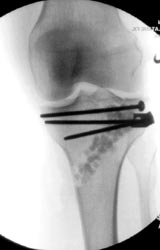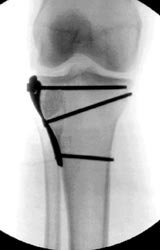Calcium sulfate bone void fillers feature quick, predictable resorptionption
They resorb in as little as six to 10 weeks; calcium phosphate bone void fillers can take years to resorb.
The first internal use of Gypsum (plaster of Paris) to fill bony defects was reported more than 100 years ago, and its use has been supported by various studies. But the recrystallization of calcium sulfate after it is mixed with water is random and produces variability and defects in the crystalline structure.
More recently developed medical-grade calcium sulfates, however, produce regularly shaped crystals that result in slower, more predictable solubility and resorption. One of these materials is OsteoSet from Wright Medical Technology Inc. (Warsaw, Ind.), which was approved in 1996. OsteoSet is available as pellets or as a resorbable bead kit that can be used to repair contained metaphyseal defects, or benign bone lesions, or to fill osteomyelitic bone voids.
J. Tracy Watson, MD, of the St. Louis University School of Medicine, has been using OsteoSet for about 10 years and finds it effective. “I was really very impressed with its properties and its ease of use and with how predictably it osteointegrates and becomes incorporated into bone.”
Filling metaphyseal voids
Watson, who is primarily a fracture and trauma surgeon, uses OsteoSet to fill metaphyseal voids following reduction of articular surfaces. While he has used calcium phosphate-based products, he prefers sulfate compounds because they integrate predictably in eight to 10 weeks as opposed to taking two to three years.
Wright recently launched MIIG X3 (Minimally Invasive Injectable Graft), a calcium sulfate-based product that is indicated for treating a variety of fractures and bone lesions. Watson had a study published recently in Orthopedics evaluating the use of MIIG X3 in eight patients with severely comminuted proximal or distal tibial metaphyseal fractures.
|
||||||
MIIG X3 was used to provide temporary intraoperative structural support until instrumentation could be appropriately placed. Bone regrowth was observed in all patients and, in seven of the eight, 90% to 100% bone formation was observed within three months. Although the sample size was small, the success rate of maintaining the articular reductions in these fractures was significantly better than in reports using traditional autograft materials.
Mix with antibiotics
Watson has used OsteoSet to make beads impregnated with antibiotics and said MIIG X3 is also useful for delivering antibiotics. “This is still OsteoSet, but in an injectable, liquid form. You can just pour antibiotics right into it so that you have antibiotics thoroughly infiltrating this material.”
Another calcium sulfate-based product is BonePlast from Interpore Cross International (Irvine, Calif.), which is indicated for use as a nonload-bearing bone void filler. It is a powder that is hydrated with saline; the resulting material can then be used to make beads or dough for larger defects. It is osteoconductive and resorbs in six to eight weeks; Interpore Cross is now pursuing an injectable indication for BonePlast.
Watson said another advantage of calcium sulfate products is that they can be placed near a joint without fear of what will happen if they migrate into the joint. If larger ceramic particles from calcium phosphates migrate into a joint, they could grind against surfaces and cause damage.
“The calcium sulfate materials act like a true salt in a fluid dynamic like a joint. … It just dissolves so you don’t have abrasive particles wearing on the joint surfaces.”
Dr. Watson is a paid consultant for Wright Medical Technology Inc.



